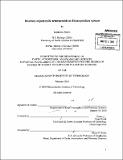| dc.contributor.advisor | Tanja Bosak. | en_US |
| dc.contributor.author | Harris, Katherine, S.M. Massachusetts Institute of Technology | en_US |
| dc.contributor.other | Massachusetts Institute of Technology. Dept. of Earth, Atmospheric, and Planetary Sciences. | en_US |
| dc.date.accessioned | 2010-09-02T14:59:49Z | |
| dc.date.available | 2010-09-02T14:59:49Z | |
| dc.date.copyright | 2010 | en_US |
| dc.date.issued | 2010 | en_US |
| dc.identifier.uri | http://hdl.handle.net/1721.1/58195 | |
| dc.description | Thesis (S.M.)--Massachusetts Institute of Technology, Dept. of Earth, Atmospheric, and Planetary Sciences, 2010. | en_US |
| dc.description | Cataloged from PDF version of thesis. | en_US |
| dc.description | Includes bibliographical references (p. 22-24). | en_US |
| dc.description.abstract | Sedimentary rocks of all ages abound with geostable lipids of microbial origin, but many biomarkers lack known organismal sources and clear environmental contexts. Here we used Rhodospirillum rubrum, a metabolically versatile, genetically tractable c-Proteobacterium, to explore the diversity of its non-polar terpenoids as a function of growth condition and growth phase. We analyzed the nonpolar fraction of lipids extracted from R. rubrum grown under aerobic, anaerobic, heterotrophic and phototrophic conditions and detected a variety of bicyclic, tricyclic, tetracyclic and pentacyclic triterpenoids, derived from the enzymatic cyclization of squalene and produced in amounts comparable to diploptene. Identified compounds included bicyclic polypodatetraenes, malabaricatriene, euphadiene, adianane, and fernene. Prior to this work, malabaricatriene was an "orphan" biomarker suspected to have a microbial origin, yet it lacked a proven source. We observed similar patterns of polycyclic terpenoids in other hopanoid-producing c-proteobacteria, including Zymomonas mobilis, Rhodopseudomonas palustris, and Rhodomicrobium vannielii. The presence and relative abundance of polycyclic triterpenoids in R. rubrum varied with the growth stage (exponential versus early stationary phase) and growth condition (photoheterotrophic versus photoautotrophic growth). Since R. rubrum's genome contains a single squalene-hopene cyclase gene, the array of triterpenoids produced by it and other c-proteobacteria likely evolves from this enzyme performing low-fidelity cyclization. The observed diversity of sedimentary triterpenoids might therefore result from a select few squalene-hopene cyclase enzymes operating with varying specificity under a range of physiological and environmental conditions, rather than reflecting a great diversity of squalene-hopene cyclases. | en_US |
| dc.description.statementofresponsibility | by Katherine Harris. | en_US |
| dc.format.extent | 24 p. | en_US |
| dc.language.iso | eng | en_US |
| dc.publisher | Massachusetts Institute of Technology | en_US |
| dc.rights | M.I.T. theses are protected by
copyright. They may be viewed from this source for any purpose, but
reproduction or distribution in any format is prohibited without written
permission. See provided URL for inquiries about permission. | en_US |
| dc.rights.uri | http://dspace.mit.edu/handle/1721.1/7582 | en_US |
| dc.subject | Earth, Atmospheric, and Planetary Sciences. | en_US |
| dc.title | Diversity of polycyclic triterpenoids in Rhodospirillum rubrum | en_US |
| dc.type | Thesis | en_US |
| dc.description.degree | S.M. | en_US |
| dc.contributor.department | Massachusetts Institute of Technology. Department of Earth, Atmospheric, and Planetary Sciences | |
| dc.identifier.oclc | 650994502 | en_US |
